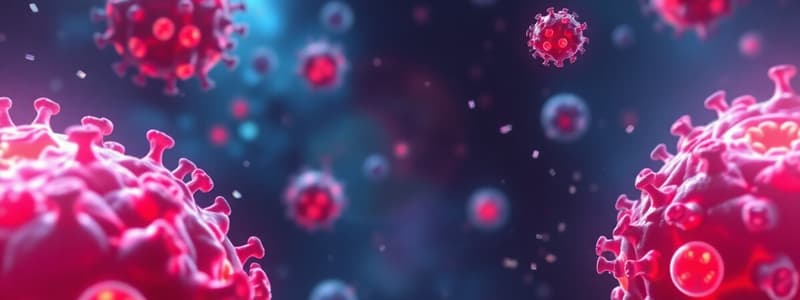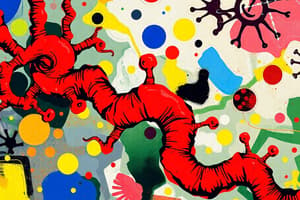Podcast
Questions and Answers
Which type of T cells recognizes peptide antigens associated with class I MHC molecules?
Which type of T cells recognizes peptide antigens associated with class I MHC molecules?
- Memory T cells
- Regulatory T cells
- CD8 + T cells (correct)
- CD4 + T cells
What is the maximum length of peptides that can bind to class II MHC molecules?
What is the maximum length of peptides that can bind to class II MHC molecules?
- 30 amino acids or more (correct)
- 6 amino acids
- 16 amino acids
- 12 amino acids
What enhances the expression of MHC gene products?
What enhances the expression of MHC gene products?
- Cytokines such as IFN-γ (correct)
- Protein degradation
- Antigen presentation
- T cell activation
What role do molecules produced during innate immune responses play in adaptive immunity?
What role do molecules produced during innate immune responses play in adaptive immunity?
What do polymorphic MHC residues form to determine the binding specificities for peptides?
What do polymorphic MHC residues form to determine the binding specificities for peptides?
Where are class I MHC molecules expressed?
Where are class I MHC molecules expressed?
What is the function of IL-10 in the immune response?
What is the function of IL-10 in the immune response?
Which component primarily delivers peptides to the endoplasmic reticulum for class I MHC binding?
Which component primarily delivers peptides to the endoplasmic reticulum for class I MHC binding?
Which of the following distinguishes between different antibody isotypes?
Which of the following distinguishes between different antibody isotypes?
What is one characteristic of antibody molecules?
What is one characteristic of antibody molecules?
What is the initial step in the antigen processing pathway?
What is the initial step in the antigen processing pathway?
How do complement fragments generated by the alternative pathway function?
How do complement fragments generated by the alternative pathway function?
Which cells primarily express class II MHC molecules?
Which cells primarily express class II MHC molecules?
What is the significance of hypervariable regions in antibodies?
What is the significance of hypervariable regions in antibodies?
What is the role of autophagy gene products in inflammatory responses?
What is the role of autophagy gene products in inflammatory responses?
What defines the antigen-combining site of an antibody?
What defines the antigen-combining site of an antibody?
What is the primary outcome of complement activation on microbial surfaces?
What is the primary outcome of complement activation on microbial surfaces?
Which pathways initiate the activation of the complement system in innate immunity?
Which pathways initiate the activation of the complement system in innate immunity?
What role do cytokines such as IL-1 and TNF play in innate immune responses?
What role do cytokines such as IL-1 and TNF play in innate immune responses?
Which of the following best describes the function of PAMPs and DAMPs in the immune response?
Which of the following best describes the function of PAMPs and DAMPs in the immune response?
How do phagocytes generally eliminate microbes?
How do phagocytes generally eliminate microbes?
Which cytokine is primarily involved in systemic effects like fever and acute-phase protein synthesis?
Which cytokine is primarily involved in systemic effects like fever and acute-phase protein synthesis?
What best describes the role of macrophages in tissue repair during an immune response?
What best describes the role of macrophages in tissue repair during an immune response?
What distinguishes microbial surfaces from normal host cells in terms of complement activation?
What distinguishes microbial surfaces from normal host cells in terms of complement activation?
What is the role of mast cells and basophils during an allergic response?
What is the role of mast cells and basophils during an allergic response?
Which of the following is NOT a manifestation of immediate hypersensitivity?
Which of the following is NOT a manifestation of immediate hypersensitivity?
What is the most severe form of immediate hypersensitivity?
What is the most severe form of immediate hypersensitivity?
What triggers the late-phase reaction in immediate hypersensitivity?
What triggers the late-phase reaction in immediate hypersensitivity?
What type of allergic reactions can food allergens cause?
What type of allergic reactions can food allergens cause?
What is the main goal of desensitization immunotherapy?
What is the main goal of desensitization immunotherapy?
How does genetic susceptibility impact allergic diseases?
How does genetic susceptibility impact allergic diseases?
Which type of receptor-targeted therapy is approved for some allergic diseases?
Which type of receptor-targeted therapy is approved for some allergic diseases?
What characterizes the earliest B cell precursors known as pro-B cells?
What characterizes the earliest B cell precursors known as pro-B cells?
At which stage does V-D-J recombination complete at the Ig heavy chain locus?
At which stage does V-D-J recombination complete at the Ig heavy chain locus?
What does the pre-B cell receptor consist of?
What does the pre-B cell receptor consist of?
What process occurs as immature B cells differentiate to prevent self-reactivity?
What process occurs as immature B cells differentiate to prevent self-reactivity?
What is the significance of allelic exclusion during B cell maturation?
What is the significance of allelic exclusion during B cell maturation?
What is the primary type of immunoglobulin expressed on the surface of immature B cells?
What is the primary type of immunoglobulin expressed on the surface of immature B cells?
What occurs during the early stages of T cell maturation in the thymus?
What occurs during the early stages of T cell maturation in the thymus?
Which of the following describes the pre-T stage of thymocytes?
Which of the following describes the pre-T stage of thymocytes?
What is the primary role of class I MHC molecules in the immune response?
What is the primary role of class I MHC molecules in the immune response?
Which process allows dendritic cells to present antigens from virus-infected cells to CD8 + T cells?
Which process allows dendritic cells to present antigens from virus-infected cells to CD8 + T cells?
What happens to the invariant chain (Ii) associated with class II MHC molecules during antigen processing?
What happens to the invariant chain (Ii) associated with class II MHC molecules during antigen processing?
How do class II MHC molecules primarily contribute to the activation of the immune response?
How do class II MHC molecules primarily contribute to the activation of the immune response?
Which component is involved in the removal of CLIP from the peptide-binding cleft of class II MHC molecules?
Which component is involved in the removal of CLIP from the peptide-binding cleft of class II MHC molecules?
What does the presence of foreign protein antigens rely on in terms of immunogenicity?
What does the presence of foreign protein antigens rely on in terms of immunogenicity?
Which statement accurately reflects the function of signaling receptors on the cell surface?
Which statement accurately reflects the function of signaling receptors on the cell surface?
What is the main pathway for presenting antigens derived from extracellular microbes?
What is the main pathway for presenting antigens derived from extracellular microbes?
Flashcards
Complement System
Complement System
A group of proteins in the blood that work together to destroy pathogens. They are activated in a cascade, leading to the formation of fragments of C3 and C5, which promote inflammation and phagocytosis.
MBL (Mannose-binding lectin)
MBL (Mannose-binding lectin)
Proteins that are activated when they bind to specific molecules on microbial surfaces. They initiate the alternative and lectin pathways of complement activation.
Phagocytosis
Phagocytosis
The process by which microbes are engulfed and destroyed by phagocytes. This is a key function of innate immunity.
Phagocytes
Phagocytes
Signup and view all the flashcards
Neutrophil
Neutrophil
Signup and view all the flashcards
Macrophage
Macrophage
Signup and view all the flashcards
Cytokines
Cytokines
Signup and view all the flashcards
TNF (Tumor necrosis factor)
TNF (Tumor necrosis factor)
Signup and view all the flashcards
What are antigen-presenting cells (APCs)?
What are antigen-presenting cells (APCs)?
Signup and view all the flashcards
What are the roles of cytokines and costimulators in adaptive immunity?
What are the roles of cytokines and costimulators in adaptive immunity?
Signup and view all the flashcards
What role does the complement system play in adaptive immunity?
What role does the complement system play in adaptive immunity?
Signup and view all the flashcards
What is the function of IL-10 in immune regulation?
What is the function of IL-10 in immune regulation?
Signup and view all the flashcards
What are antibodies (immunoglobulins)?
What are antibodies (immunoglobulins)?
Signup and view all the flashcards
What is the function of membrane-bound antibodies?
What is the function of membrane-bound antibodies?
Signup and view all the flashcards
What is the function of secreted antibodies?
What is the function of secreted antibodies?
Signup and view all the flashcards
What are hypervariable regions in antibodies?
What are hypervariable regions in antibodies?
Signup and view all the flashcards
MHC Class I & II Presentation
MHC Class I & II Presentation
Signup and view all the flashcards
MHC Peptide Binding
MHC Peptide Binding
Signup and view all the flashcards
MHC Binding Specificity
MHC Binding Specificity
Signup and view all the flashcards
MHC Cleft Size
MHC Cleft Size
Signup and view all the flashcards
MHC Expression
MHC Expression
Signup and view all the flashcards
Antigen Processing
Antigen Processing
Signup and view all the flashcards
Class I MHC Pathway
Class I MHC Pathway
Signup and view all the flashcards
MHC Surveillance
MHC Surveillance
Signup and view all the flashcards
Cross-presentation
Cross-presentation
Signup and view all the flashcards
TAP-containing peptide-loading complex
TAP-containing peptide-loading complex
Signup and view all the flashcards
CLIP
CLIP
Signup and view all the flashcards
DM
DM
Signup and view all the flashcards
MHC molecules
MHC molecules
Signup and view all the flashcards
CD8+ cytotoxic T lymphocytes (CTLs)
CD8+ cytotoxic T lymphocytes (CTLs)
Signup and view all the flashcards
CD4+ helper T cells
CD4+ helper T cells
Signup and view all the flashcards
Immediate hypersensitivity
Immediate hypersensitivity
Signup and view all the flashcards
Anaphylactic shock
Anaphylactic shock
Signup and view all the flashcards
Asthma
Asthma
Signup and view all the flashcards
Allergic rhinitis
Allergic rhinitis
Signup and view all the flashcards
Late-phase reaction
Late-phase reaction
Signup and view all the flashcards
Atopic susceptibility
Atopic susceptibility
Signup and view all the flashcards
Desensitization immunotherapy
Desensitization immunotherapy
Signup and view all the flashcards
Monoclonal antibodies for allergy treatment
Monoclonal antibodies for allergy treatment
Signup and view all the flashcards
V(D)J Recombination
V(D)J Recombination
Signup and view all the flashcards
Pro-B Cells
Pro-B Cells
Signup and view all the flashcards
Pro-B to Pre-B Cell Transition
Pro-B to Pre-B Cell Transition
Signup and view all the flashcards
Pre-B Cell Receptor
Pre-B Cell Receptor
Signup and view all the flashcards
B Cell Maturation in Bone Marrow
B Cell Maturation in Bone Marrow
Signup and view all the flashcards
T Cell Maturation: Thymus Outer Cortex
T Cell Maturation: Thymus Outer Cortex
Signup and view all the flashcards
Pre-T Stage
Pre-T Stage
Signup and view all the flashcards
Double-Positive T Cells
Double-Positive T Cells
Signup and view all the flashcards
Study Notes
Immune Responses
- Protective immunity is mediated by innate and adaptive immunity
- Innate immunity responds to shared microbial structures and host cell damage
- Adaptive immunity is specific to different antigens with enhanced responses upon repeat exposure
- Adaptive immunity features antigen specificity, diverse repertoire, memory, and discrimination between self and foreign antigens
- Immunity can be active (via antigen response) or passive (via antibody/effector cell transfer)
- Lymphocytes (B cells and T cells) are the key cells in adaptive immunity, each with unique antigen receptors
- Adaptive immunity starts with antigen recognition by specific lymphocytes; antigen-presenting cells display antigens
- Lymphocytes proliferate and differentiate into effector (antigen elimination) and memory cells (enhanced responses)
- Humoral immunity (B cells and plasma cells) eliminates extracellular microbes via antibodies (neutralization, phagocytosis promotion)
- Cell-mediated immunity (T cells) fights intracellular microbes via cytokines (like CD4+ helper T cells assisting macrophages and CD8+ cytotoxic T cells killing infected cells)
Cells and Tissues of the Immune System
- Immune system organization is key for effective innate and adaptive responses (rapid delivery of cells to infection sites, antigen location for lymphocytes)
- Major effector cells include phagocytes (neutrophils, macrophages), mast cells, basophils, eosinophils, dendritic cells, innate lymphoid cells (ILCs), and natural killer (NK) cells, plus lymphocytes
- Surface molecules, named via the CD nomenclature, are differentially expressed on immune cells
- Neutrophils are abundant blood leukocytes, multilobed nucleus, cytoplasmic lysosomes. They are rapidly recruited for phagocytosis, microbial killing
- Tissue resident macrophages act as sentinels detecting microbes and alerting the immune system and performing specialized functions in tissues
- Monocytes are circulating phagocytes that mature to macrophages, clearing microbes, dead cells, and secreting cytokines/chemokines to recruit leukocytes and repair damage.
- Dendritic cells (DCs) are bone marrow-derived antigen-presenting cells
- Innate lymphoid cells (ILCs) are cytokine-producing, innate immune cells similar to CD4+/CD8+ T cell effector cells
- B cells and T cells express diverse, specific antigen receptors, critical for adaptive immunity specificity/memory
- B and T lymphocytes develop from a bone marrow precursor; B cells mature in marrow, T cells in the thymus before entering circulation and populating lymphoid organs
- Naive B/T cells are mature but unstimulated lymphocytes
- Effector B cells (plasma cells) secrete antibodies; effector T cells (including CD4+ helper and CD8+ cytotoxic T cells) have cytokine secretion or killing functions
- Memory cells persist to rapidly respond to repeat exposure to an antigen
Leukocyte Circulation and Migration into Tissues
- Leukocyte migration from blood to tissues involves postcapillary venules, use of chemokines and adhesion molecules on leukocytes/endothelial cells
- Selectins are carbohydrate-binding molecules mediating low-affinity leukocyte-endothelial cell interactions
- Integrins are adhesion molecules for tight leukocyte-endothelial cell binding (LFA-1, VLA-4)
- Chemokines are protein signals regulating leukocyte migration into tissues, and are bound to chemokine receptors, leading to leukocyte movement in chemotaxis along concentration gradients
- Lymphocyte recirculation is critical for naive lymphocyte encounters with antigens in secondary lymphoid organs
Studying That Suits You
Use AI to generate personalized quizzes and flashcards to suit your learning preferences.



